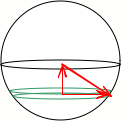Calculus
Lesson
37
Work
Back to Dr. Nandor's Calculus Notes Page
Back to Dr. Nandor's Calculus Page
From Physics, we know that ![]() ,
but this only applies when we
,
but this only applies when we
have Force is constant and the object moves in a straight line!
As an aside, don't forget that ![]() ,
but we will essentially
,
but we will essentially
only talk about force in either the same direction or in the opposite direction as
the motion, so we'll drop the dot product portion of the definition.
As with everything else, we should be able to break all of the work up into
smaller pieces.
![]()
In the differential limit, we find:
![]()
Sometimes we will use the first part, when F depends on the shape
of the differential, and sometimes we will use the second part, when
F only depends on x. Here is the rule: if the mass/weight changes, you
use
![]() . Otherwise, you use the other.
. Otherwise, you use the other.
MUST know:
![]()
(force ON a spring, x is length displaced from equilibrium.)
![]() (force of
one charge on another)
(force of
one charge on another)
![]() (force of one mass on
another)
(force of one mass on
another)
Example: The force to compress a spring 3 inches from its natural length of 15in
is 750 lbs. How much work does it take to stretch the spring another 3 in?
(Use F=kx to solve for k (250 lbs/in)). Then use ![]()
Example: A spherical tank, 8 feet in radius, is half-full of oil (50 lbs/ft3). Find the work
to pump it out the top.
![]()
Here ![]() is the force
of gravity (weight) of a slice of oil. Make sure
is the force
of gravity (weight) of a slice of oil. Make sure
everyone recognizes that each slice weighs a different amount, so this is
distinctly different from the first case, where a single thing is moving and
the force is simply dependent on x. Also, note that D is the distance any
given slice will move.


if y=0 at top

![]()
![]()
if y=0 at bottom

![]()
![]()
if y=0 in the middle

![]()
![]()
Any of these integrals gets you ![]()
Example: Lift a chain (longer than 20 feet), 5 lb/ft, so top is 20 feet off of the ground.
Call ground y=0.
![]()
![]()
![]()
![]()